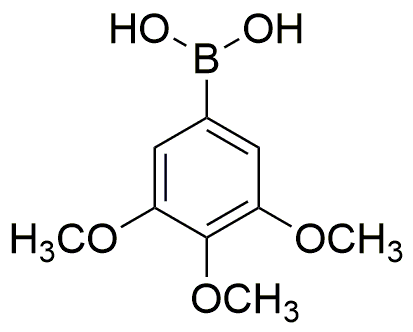3,4,5-Trimethoxyphenylboronic acid is widely utilized in research focused on:
- Organic Synthesis: This compound serves as a versatile building block in organic chemistry, facilitating the synthesis of complex molecules through Suzuki coupling reactions, which are essential in pharmaceuticals and agrochemicals.
- Drug Development: In medicinal chemistry, it is employed to create boron-containing compounds that can enhance the efficacy of drugs, particularly in targeting cancer cells, offering a strategic advantage over traditional compounds.
- Material Science: It is used in the development of advanced materials, such as polymers and nanomaterials, due to its ability to form stable complexes, which can improve the mechanical properties of the final products.
- Bioconjugation: The compound plays a crucial role in bioconjugation processes, allowing researchers to attach biomolecules to surfaces or other molecules, which is vital in the development of biosensors and targeted drug delivery systems.
- Analytical Chemistry: It is utilized in various analytical techniques, including chromatography, to improve the separation and detection of compounds, thus enhancing the accuracy of analytical results in research laboratories.
General Information
Properties
Safety and Regulations
Applications
3,4,5-Trimethoxyphenylboronic acid is widely utilized in research focused on:
- Organic Synthesis: This compound serves as a versatile building block in organic chemistry, facilitating the synthesis of complex molecules through Suzuki coupling reactions, which are essential in pharmaceuticals and agrochemicals.
- Drug Development: In medicinal chemistry, it is employed to create boron-containing compounds that can enhance the efficacy of drugs, particularly in targeting cancer cells, offering a strategic advantage over traditional compounds.
- Material Science: It is used in the development of advanced materials, such as polymers and nanomaterials, due to its ability to form stable complexes, which can improve the mechanical properties of the final products.
- Bioconjugation: The compound plays a crucial role in bioconjugation processes, allowing researchers to attach biomolecules to surfaces or other molecules, which is vital in the development of biosensors and targeted drug delivery systems.
- Analytical Chemistry: It is utilized in various analytical techniques, including chromatography, to improve the separation and detection of compounds, thus enhancing the accuracy of analytical results in research laboratories.
Documents
Safety Data Sheets (SDS)
The SDS provides comprehensive safety information on handling, storage, and disposal of the product.
Product Specification (PS)
The PS provides a comprehensive breakdown of the product’s properties, including chemical composition, physical state, purity, and storage requirements. It also details acceptable quality ranges and the product's intended applications.
Certificates of Analysis (COA)
Search for Certificates of Analysis (COA) by entering the products Lot Number. Lot and Batch Numbers can be found on a product’s label following the words ‘Lot’ or ‘Batch’.
*Catalog Number
*Lot Number
Certificates Of Origin (COO)
This COO confirms the country where the product was manufactured, and also details the materials and components used in it and whether it is derived from natural, synthetic, or other specific sources. This certificate may be required for customs, trade, and regulatory compliance.
*Catalog Number
*Lot Number
Safety Data Sheets (SDS)
The SDS provides comprehensive safety information on handling, storage, and disposal of the product.
DownloadProduct Specification (PS)
The PS provides a comprehensive breakdown of the product’s properties, including chemical composition, physical state, purity, and storage requirements. It also details acceptable quality ranges and the product's intended applications.
DownloadCertificates of Analysis (COA)
Search for Certificates of Analysis (COA) by entering the products Lot Number. Lot and Batch Numbers can be found on a product’s label following the words ‘Lot’ or ‘Batch’.
*Catalog Number
*Lot Number
Certificates Of Origin (COO)
This COO confirms the country where the product was manufactured, and also details the materials and components used in it and whether it is derived from natural, synthetic, or other specific sources. This certificate may be required for customs, trade, and regulatory compliance.


